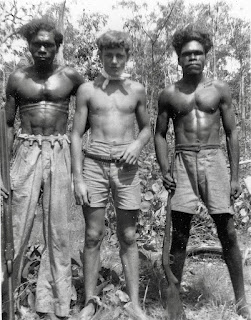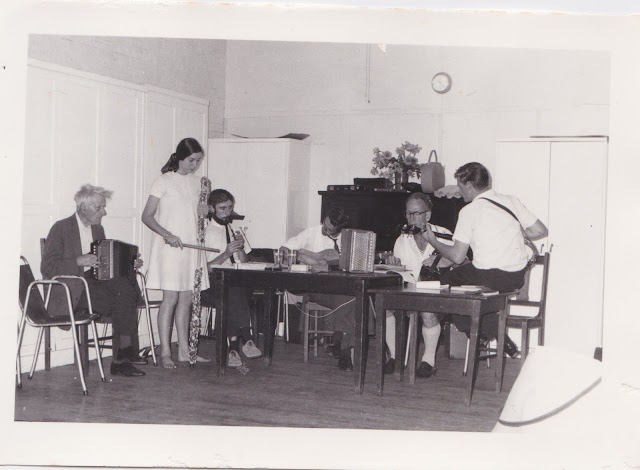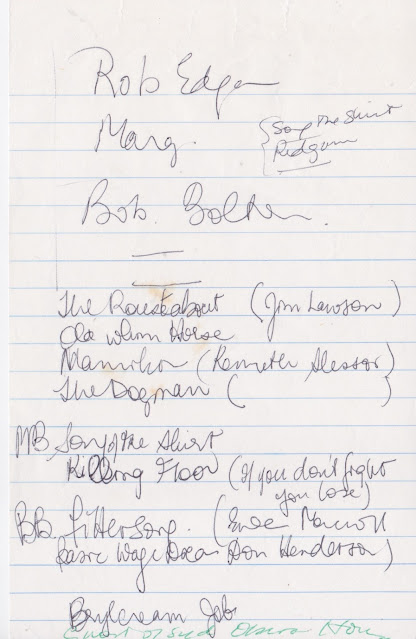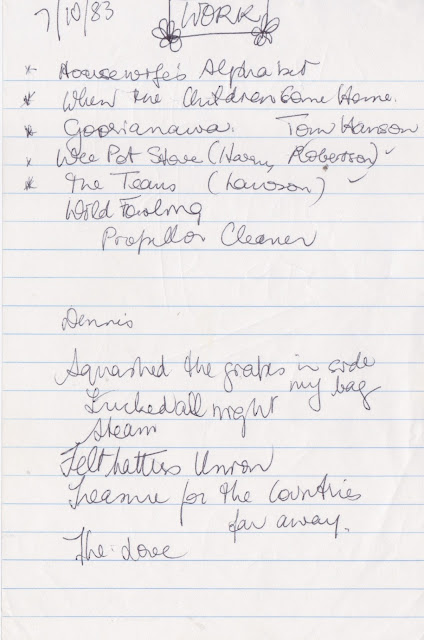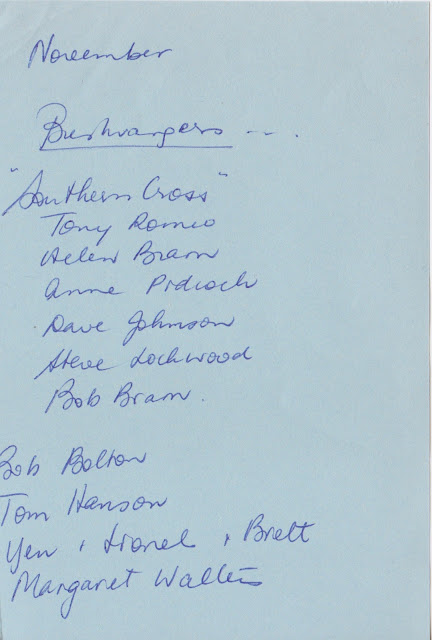Click images for larger size.
REMINISCENCES of the BUSH MUSIC CLUB IN the 1960s.
 |
| Chris c. 1963 by John Meredith, published in Singabout 6(2), 1967, p.10 |
When did you join?
I think I joined the BMC in late 1962, but am unsure. Perhaps it was 1963. I do remember that in 1963 the Leyland Brothers ran their first TV documentary which was called Down the Darling. Alan Scott was featured singing in the background.The person to convince me to join the club was Barbara Strain, later to marry George Gibbons. Barbara and I met on the set of one of Edgar Penzig’s films the title of which now eludes me. Edgar had asked me to be the main character as I had been a horseman and, I suspect, because of my suitable age of about 23 years. Barbara was playing the main female character, a lone bush woman who was threatened by an escaped convict. In the end I come galloping through the bush, save the lady, by running the evil intender down and shooting him from the saddle.
At dinner camp Barbara and I had a chat and she asked if I had learnt any de-tribalised Aboriginal songs while I was working in the outback. I said that I knew a couple and she asked if I could come to her place and record them for her. She also suggested that I should join the Bush Music Club and should go along sometime. A couple of weeks after I went to her place to record the songs, where I also met George Gibbons. Following that meeting I joined the BMC. [I suppose this should have been under Why Did I join?]
Why did you join?
Coming from the parents that I did, I grew up with a strong understanding of how our Australian culture was always overshadowed by the British and how we were made to feel inferior, hence the Great Australian Cringe. I was always interested in Australian songs and poetry, history and geography. In 1952 at the age of almost 15, 7 years after World War 11 ended, I had the experience of a lifetime. My Territorian uncle took me up through outback NSW and Qld - very little bitumen then! – to the Northern Territory and onto Snake Bay, Melville Island where the Tiwi people were still very tribal. My association and experiences with those special people left me with another life-long very Australian passion.
Wilfred, Chris & Len, Tiwi Island
After I had visited the club once or twice, I was outside approaching the building when I heard the most beautiful music, a music which I had never heard before. I was listening to the violin and Uilleann pipes of Barney Heffernan and Billy Crowe. This music must have been in my DNA as it seemed to awaken something within me. These two musicians had been invited along because it was close to St Patrick’s Day.
First impressions?
I was immediately very impressed with the ballads sung there. It also gave me a good introduction to music and musicians. People were particularly friendly and decidedly left wing, which suited my inclinations.
Of course the bush ballads the club members were singing were not the songs that we had been singing outback. Out there were singing Slim Dusty’s When the Rain Tumbles Down in July, Sweeney, Saddle Boy, When the Sun Goes Down Outback etc, as well as the songs of Hank Williams and other American country music singers. On Saturday nights we would sit around the campfire listening to my modern eight-battery transistor to such horribly named stations such as 2WG Wagga’s Riverina Ranch. The most popular request on these stations for ages was Alan Scott singing the Drover’s Dream. I can still recall how we would sit around leaning in then out as the signal faded then strengthened.
Where was the Club meeting?
When I joined it was held on the eastern side of lower Clarence Street in Sydney. I can’t recall the address, but I am sure it is somewhere in other records of the club. The place went back to the horse-drawn days. Facing from the street it had a large door which took up most of the width, with a set of stairs on the right-hand side which led up to the floor above the large area underneath. This area was rented by the Fellowship of Australian Writers NSW. I was excited in this environment, with the writings of Mary Gilmore, Rod Quinn and other renowned writers and poets. The place was very old if not ancient, and I am certain that the floor had a bounce in it of about 2 inches (50 mm) during the dancing.
Workshop Nights? - Meeting nights were really workshop nights. Occasionally a committee meeting would be held to discuss such things as Singabout nights and recording records.
Held where? – Workshop nights were held every Tuesday night. It was held in the Fellowship of Australian Writers room in lower Clarence Street when I was a new member and when I became MC of the club.
 |
| Workshop door takings Tuesday 23rd May 1967 |
How many attended? – Attendance varied of course, but I would estimate that on the usual evening there would be six or seven musicians and about fifteen or twenty or more adults, and usually a few children.
Structure of night? – I probably followed organising the evening similar to that which Frank Maher had. Frank had been the MC prior to me. We would commence with a few songs which had been selected by me from our Singabout publications and later The Penguin Australian Song Book (1964) by John Manifold. The club had their own copies of these books and would share them around on workshop evenings, collecting them at the end of each evening and storing them in a cupboard for the purpose.
After the few songs we would hold a dance, which was followed by requested songs. Most, if not all requests came from the sources already mentioned. Following the request section (usually ran anticlockwise for some unknown reason!) attendees were given the option of performing their own particular solo numbers. Of course, this is where John Dengate would display his amazing wit and superb songwriting abilities, usually composed through the preceding week.
Another dance then a few more songs. I always finished the evening with what I considered a strong Australian song for the closure. These were songs such as Freedom on the Wallaby or the now politically incorrect Our Fathers Cleared the Bush. Having started at 7.00 pm we aimed to finish by 9.30. If the evening did finish at that time most of the men would walk hastily to the nearest pub as closing time was 10. 00 pm in those days.
On John Meredith’s suggestion I introduced a Beer and Cheese Night once a month. These would be a themed evening such as Lawson, Kelly, St Patrick’s night (in March, of course), Gilmore evenings and others that escape my memory at the moment.
Henry Lawson’s daughter Bertha attended the Lawson evenings. She would have been in her sixties then. Unfortunately she did not contribute to the evening, but we enjoyed having her there.
Performers? – Musicians included older ones like Herb Gimbert (tin whistle, button accordion and swanee whistle), Alex Bowker (mouth organ, button accordion and triangle) and Bill Tovey (button accordion and mouth organ). There was also Harry Glendinning (piano accordion), John Dengate (guitar and vocals), Ken Greenhalgh, Tony McLaughlin (was a multi-instrumentalist, but mainly played the piano accordion), Eric Bolton (on guitar and banjo). The musicians mainly sat to the left of the MC, though some would sit amongst those sitting down either side or across the far end of the rectangular shaped room.
Dances? – In those days we only had seven dances, which I eagerly learnt and enjoyed calling each workshop night. I would talk through the steps and movements before commencing with me as MC, dancing and calling, throughout the dance. I really enjoyed the calling and dancing. Perhaps if I had joined the musicians I would have improved my accordion playing and developed a better sense of timing. I knew this at the time, but still chose the dancing.
 |
| Maher collection - Dance afternoon at Noreen Grunseit's place |
The seven dances were:.
Strip the Willow (my definite favourite!)
Haymakers Jig
Circassian Circle
Brown Jug Polka
Virginia Reel
Flying Pieman
Galopede
Singabout Nights? – I only attended a few of these over the years and recall it being held the Sydney Trades Hall in George Street. I think it was sometimes held elsewhere. Venue probably depended on availability on the day. These nights occurred every quarter if I recall correctly.
Held where? – As mentioned above.How many attended? - Decidedly more than for the weekly workshops. Different faces would appear at these functions.
Structure of night? – A general concert form. The concert party and other members would perform and I think that individual artists would also entertain with a song or two. There were some dancers too, always a favourite with the women, as it was on workshop evenings. As I attended very few of the Singabout Concerts, and I think that they were held on Saturdays when I was usually out of town, my memories are not very strong regarding this matter.
Performers? – Duke Tritton, Silvia and Tom Salisbury, and the Bush Music Club’s Concert Party. Probably the Three Galahs (the Grivas Brothers), appropriately dressed in white moleskin trousers, pink shirts and grey vests). There others whom I can’t recall. Perhaps Jamie Carlin (concertina), and Tony Laughlin performed on these evenings also.
Dances? – Probably the same as on Workshop Nights (see above).
What other activities? – The Concert Party would perform at various locations as invited. Many members, especially the Marrickville Girls (see below), would accompany members of the Wild Colonial Days Society (of which I was a founding member) when they visited country towns to re-enact the centenary of notable or notorious deeds of the 1860 bushrangers. Dressed in colonial attire of those times for the re-enactments also suited the concerts and dances which were often held at these venues.
At my suggestion we visited the Araluen Valley one weekend. My friend Molly Collins, proprietor of the Araluen Hotel, had advertised so widely that the Concert Party had to perform on the main - and only - street!
Year you became MC? – Probably mid 1963. It was not a long time after I first joined. Frank Maher was the MC when I joined and he had had enough of the position and both he and Merro kept urging me to take the position.
Concert Party? – The Concert Party consisted of John Meredith (button accordion), Harry Glendinning (piano accordion), Eric Bolton (guitar and banjo) and John Dengate (guitar). I think that Tony McLaughlin, a multi-instrumentalist and Ken Greenhalgh (flautist) could have been members also. They could have been casual members as I know that people came and went.
I was never a member of the CP but joined them for the 1967 centenary Lawson album – Poems in Music . I played the mouth organ (the traditional Australian name for the harmonica) and sang. Others on the record were: John Meredith, Harry Glendinning, Brian Loughlin, Frank Maher and Jamie Carlin. It is worth noting that in these years Alan Scott was working night shifts so could not attend Workshop nights. Up until about ’64 Duke belonged to the Concert Party and was a regular attendee.
Other Bands in Club? – In those days members had not formed separate bands as they did later.
Women in the Club? - Pam Loughlin was usually there with her children (Brian was working shift work in those days.) Janet Wakefield, Barbara Gibbons (nee Strain), Dale Morgan (to become Dengate), Rhonda Carlin and the ‘Marrickville Girls’: Sisters Coralie and Evie Baldwin (Australian), Alwena ‘Wenna’ Brooks (Welsh), Rose and Violet ‘Vi’ Jackson (English), Brenda O’Conner (Liverpool, England), Elenor Parker (English) and Caroline Purser from Co Mayo, Ireland. Coralie (deceased) Baldwin married Ray Smith who came along to many BMC workshops (who was also a member of the WCDS), Rose Jackson married Ralph Pride and Morris Matthias (BMC member) married Caroline Purser. Despite an impaired foot Caroline was an accomplished dancer. Some others from the same Marrickville address, whose names I cannot recall, came and went, having been brought along by the dedicated group from Marrickville. Here again it is worth noting that Gay Scott rarely attended because Alan was working night shifts and she had two young sons, Bill and Ashley.
Children in the Club? – I don’t recall many children attending the workshops though they would accompany members sometimes. Jenny Loughlin and her sibling were usually brought along by their mother Pam. Bob, then the other Bolton brother were brought along by Eric.
The Folk Revival in the 1960s
Most of the songs we sang came from our Singabout booklets and Manifolds The Penguin Australian Song Book. The most popular song requested by the BMC female members was without doubt Stan Wakefield’s Wallaby Liz. Other popular requests were Five and a Zack, The Broken Down Squatter, Lawson’s The Shearer’s Dream, Freedom on the Wallaby, Cane Killed Abel, The Overlander, Ladies of Brisbane, Stan Wakefield’s The Stock Route Again and innumerable other titles including The Old Bark Hut, Norman Brown, Various songs to the Ten Thousand Miles Away tune, Charlie Mopps (of course!), Maggie May, The Catalpa, Streets of Forbes, some Kelly songs and most of the shearing songs such as The Ryebuck Shearer, Goorianawa and Widgegoara Joe etc.
Was overseas folk music influencing the Club? I cannot recall the singing of any songs that were hitting the airwaves from either Britain or America even though they were gaining popularity with the general populace. After all, we had plenty of good songs to enjoy, protect and popularise!
Others who attended. – Some interesting people attended Workshop evenings at times. These included a chap who was known by the name of Doc (or was it Professor?) who I recall dressed in an impressive manner and performed in a vaudevillian way. His act was playing the saw with a bow. He was very good at playing known tunes. The Doc (or Prof) would turn up probably once every eighteen or twenty-four months.
One bloke turned up only once. He had a reasonable voice, but was a yodeller, a terrible one. Later that evening I asked Jamie Carlin what he thought of our visitor and he said, ‘He was that bad he was good!’
As mentioned earlier, Henry Lawson’s daughter Bertha would turn up once a year once we introduced the Beer and Cheese Night and held our Lawson Night every June.
Chris Woodland, 17 April 2020, (Questions from Kerry Dougherty for Chris Woodland).
~~~~~~~~

